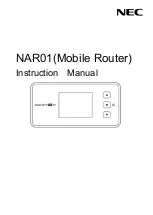
System Configuration
36
NXA-WAP250G 802.11b/g Wireless Access Point
Wireless VAP Settings - WEP Setting
The WAP-250G is configured by default as an “open system,” which broadcasts a beacon signal
including the configured SSID. Wireless clients with a configured SSID of “any” can read the SSID from
the beacon and automatically set their SSID to allow immediate connection to the WAP-250G. To secure
the wireless network, you have to implement user authentication and wireless data encryption.
Wired Equivalent Privacy (WEP) provides a basic level of security, preventing unauthorized access to the
network and encrypting data transmitted between wireless clients and the WAP-250G. WEP uses static
shared keys (fixed-length hexadecimal or alphanumeric strings) that are manually distributed to all
clients that want to use the network (FIG. 33).
The items on this page include:
WEP Status
: Enables the WAP-250G to use WEP shared keys. If enabled, you must
configure at least one key for the VAP interface and all its clients.
Authentication Mode
: Select
Open
or
Shared
.
Open
system authentication simply consists of two communications. The first is an
authentication request by the client that contains the station ID (typically the MAC address).
This is followed by an authentication response from the AP/router containing a success or
failure message. An example of when a failure may occur is if the client's MAC address is
explicitly excluded in the AP/router configuration.
For
Shared
key authentication, the AP generates some random string of ASCII text, and sends
it CLEARTEXT to the Station. The station encrypts the text using the configured WEP key,
and sends it ENCRYPTED to the AP. The AP then decrypts it to see if the starting ASCII
string is produced. This ensures both sides have the same key.
FIG. 33
Wireless VAP 1 Setting - WEP Security
AMX recommends using Open due to security issues that can occur with Shared.
If more than one part of the encryption scheme are sent, it becomes much more easy
for a hacker to figure out the WEP key. Therefore, it is generally recommended to no
longer use shared key authentication.
Summary of Contents for NXA-WAP250G
Page 26: ...Initial Configuration 22 NXA WAP250G 802 11b g Wireless Access Point ...
Page 54: ...System Configuration 50 NXA WAP250G 802 11b g Wireless Access Point ...
Page 58: ...Appendix A Troubleshooting 54 NXA WAP250G 802 11b g Wireless Access Point ...
Page 59: ...Glossary 55 NXA WAP250G 802 11b g Wireless Access Point ...
















































